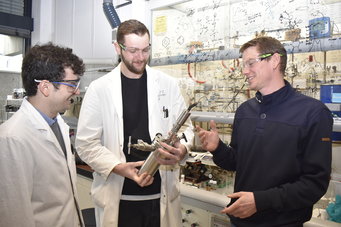
This image of the sun was taken from the University of Washington campus in late March. It was taken using a telescope that captures images using a certain wavelength of light emitted by hydrogen, the most common element in the sun. Solar flares, sunspots and other features are visible on the sun’s surface. During the eclipse the blocking of the sun’s central region will reveal more detail along the outer edges.Baptiste Journaux/University of Washington
On Monday, large parts of the United States will experience a total solar eclipse. This eclipse is expected to be a more significant event than the one in 2017, and the next one visible from the U.S. won’t happen until 2044. The sky will darken in Uvalde, Texas, just seconds before 2:30 p.m. Eastern Time (1:30 p.m. local time in Texas) on April 8. The eclipse’s path will then arc up through Arkansas, Missouri, Illinois, Ohio and New York state before exiting the U.S. over Maine at 3:30 p.m. Eastern Time. Seattle is on the outer edge of the eclipse’s effects, with skies expected to darken here just 20% below regular levels.
Among the many people travelling to witness the total eclipse firsthand will be Baptiste Journaux, a University of Washington research assistant professor of Earth and space sciences, along with four UW graduate students.
Journaux’s research combines results from experiments and space missions to understand Earth as well as other planets and moons within our solar system. For this trip he will bring a special telescope to capture the unique view of the sun and surrounding skies that becomes possible during a solar eclipse.
UW News asked Baptiste about the upcoming trip as part of an occasional series, “In the Field,” highlighting UW field efforts.

This image of the Aug. 21, 2017, total solar eclipse was captured from Idaho with the corona, or hairlike features around the disc, clearly visible. The 2024 eclipse is expected to have a corona with a greater extension due to the more active solar cycle.Baptiste Journaux/University of Washington
Where are you going, and when?
Baptiste Journaux: We are currently aiming for somewhere along the border between Arkansas and Oklahoma. We will be there Sunday and Monday. The final location on Monday will depend on last-minute weather assessments to make sure we have the best chances of low cloud coverage. The choice of that general area is guided by flight prices and low population density to avoid traffic.
Have you visited this site before?
BP: No – it will be quite exploratory!
What do you and your students hope to see?
BP: First, we are hoping to be able to observe the eclipse in the totality zone without too much cloud cover for near the longest eclipse time possible (more than 4 minutes). This will be significantly longer than the 2017 eclipse. During the totality, we will be able to see the sun’s corona with the naked eye. This is the farthest-extending feature of the sun’s atmosphere and is only visible during total eclipses.
As the sun is currently approaching its activity maximum – or the peak in the roughly 11-year cycle of solar activity – we are expecting to see quite a few more solar features than in 2017. One feature we hope to see is large plasma bridges, called prominences, that are suspended over the surface of the sun by its strong magnetic field.
During totality, the sky will get dark, and we should be able to see Mercury, Venus, Mars, Jupiter and Saturn appear on both sides of the sun. There is also a comet, 12P/Pons-Brooks, that should be visible just next to Jupiter. Overall, it promises to be quite an incredible and unique spectacle.
Who will be participating in this field effort?
BP: We will be going with four Earth and space sciences graduate students – Ula Jones, Haskell Trigue White, Alysa Fintel and Andrew Shumway – as well as Sarah Smith with the College of the Environment, who will help to document the effort.
What is the telescope that you will be bringing? What do you hope to learn?
BP: We are bringing a special telescope that allows us to observe the sun in a single wavelength of hydrogen, the main constituent of the sun, to capture images of the sun’s surface features during the progression of the eclipse. We have been taking images of the sun from the UW campus to practice the use of this type of telescope, known as an H-alpha telescope.
What’s something you enjoy about going into the field?
BP: The main thing is experiencing a unique cosmic event that really gives perspective on the size and force of the universe. This is, honestly, one of the most incredible things that one can experience. Sharing that with our students will be a privilege.
Can people follow your efforts?
BP: I will post on my X account, @B_jour, and we will have full coverage through the UW Environment channels on X and Instagram.
Anything you’d like to add?
BP: Wish us luck with the weather!







